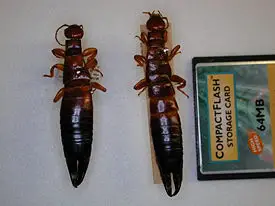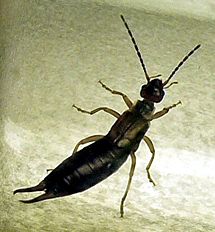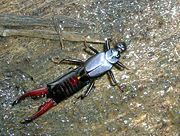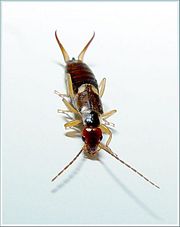Difference between revisions of "Earwig" - New World Encyclopedia
(article ready, image(s) currently in article are ok to use) |
Rick Swarts (talk | contribs) |
||
| Line 1: | Line 1: | ||
| − | {{ | + | {{otheruses4|the insect|the record label|Earwig Music Company|the American indie rock band|Earwig (band)|the 1989 power-pop album of that name|Blake Babies}} |
{{Taxobox | {{Taxobox | ||
| − | | | + | | name = Earwig |
| − | | | + | |fossil_range=[[Jurassic]] to Recent |
| image = Earwig on white background.jpg | | image = Earwig on white background.jpg | ||
| image_width = 240px | | image_width = 240px | ||
| Line 14: | Line 14: | ||
| subdivision_ranks = Families | | subdivision_ranks = Families | ||
| subdivision = | | subdivision = | ||
| − | '''Suborder Archidermaptera'''<br | + | '''Suborder Archidermaptera †'''<br> |
| − | + | '''Suborder Forficulina'''<br> | |
| − | '''Suborder Forficulina'''<br | + | :[[Pygidicranidae]] |
| − | :[[Pygidicranidae]] | + | :[[Diplatyidae]] |
| − | :[[Diplatyidae]] | + | :[[Anisolabididae]] |
| − | :[[Anisolabididae]] | + | :[[Labiduridae]] |
| − | :[[Labiduridae]] | + | :[[Apachyidae]] |
| − | :[[Apachyidae]] | + | :[[Labiidae]] |
| − | :[[ | + | :[[Chelisochidae]] |
| − | :[[Chelisochidae]] | + | :[[Forficulidae]] |
| − | :[[Forficulidae]] | + | '''Suborder Hemimerina'''<br> |
| − | '''Suborder Hemimerina'''<br | + | :[[Hemimeridae]] |
| − | :[[Hemimeridae]] | + | '''Suborder Arixenina'''<br> |
| − | '''Suborder Arixenina'''<br | ||
:[[Arixeniidae]] | :[[Arixeniidae]] | ||
}} | }} | ||
| − | |||
| − | |||
| − | ''' | + | ''' Earwigs''' is the common name given to the [[insect]] [[order (biology)|order]] '''Dermaptera''' characterized by membranous [[insect wing|wings]] folded underneath short leathery forewings (hence the literal name of the order—"skin wings"). The [[abdomen]] extends well beyond the wings, and frequently, though not always, ends in a pair of [[forceps]]-like structures termed [[cercus|cerci]]. The order is relatively small among Insecta, with about 1,800 recorded species in 10 families. Earwigs are, however, quite common globally. There is no evidence that they transmit disease or otherwise harm humans or other animals, despite their nickname ''pincher bug''. |
==Etymology== | ==Etymology== | ||
| − | [[ | + | ''Earwig'' is derived from [[Old English language|Old English]] ''ēare'' "ear" and ''wicga'', "insect". (''Wicga'' is in turn related to ''wiggle'', and ultimately to other words implying movement, including ''way'' and ''vehicle'', all from [[Proto-Indo-European language|PIE]] *''wegh-''.) The name comes from the [[old wives' tale]] that earwigs burrow into the brains of humans through the ear and therein lay their eggs.<ref>''[[Oxford English Dictionary]]'' on "Earwig".</ref> Earwigs are [[omnivore]]s that are predisposed to hiding in warm humid crevices and as such one may crawl into a human ear canal. This is not, however, a location where they are frequently found.<ref>{{Citation |
| + | |url=http://www.tolweb.org/Dermaptera | ||
| + | |title=Dermaptera — Earwigs | ||
| + | |author=Fabian Haas | ||
| + | |publisher=Tree of Life web project}}</ref> | ||
| − | + | Other languages have words based on the same premise: German ''Ohrwurm'' (also: ''Ohrkneifer'', "ear pincher"), French ''perce-oreille'', Danish ''ørentviste'', [[Slovak language|Slovak]] ''ucholak'' (''ucho'' = ear, ''lak'' = scare), and Hungarian ''fülbemászó'' ("crawler-into-the-ear"). English has derived a verb from this, ''to earwig'', meaning "to fill someone's mind with [[prejudice]] by [[insinuation]]s" or "to attempt to influence by persistent confidential [[argument]] or talk".<ref>[http://dictionary.reference.com/search?q=earwig dictionary.com: ''earwig'']</ref> | |
| + | <!-- this is NOT synonymous with eavesdrop - source: OED !--> | ||
| + | The German word ''Ohrwurm'' has the derived meaning "an annoying tune which I can't get out of my head" (see [[earworm]]). Hungarian also uses the phrase ''fülbemászó dallam'' with similar meaning as the German above, although without the negative overtones. | ||
| − | |||
==Classification== | ==Classification== | ||
Four suborders within the Dermaptera have been established: | Four suborders within the Dermaptera have been established: | ||
| − | <ref name=insecyc">Susan M. Rankin and James O. Palmer (pp. 297-299) in Resh, V. H. & R. T. Cardé (Editors) 2003. Encyclopedia of Insects. Academic Press.</ref> | + | <ref name="insecyc">Susan M. Rankin and James O. Palmer (pp. 297-299) in Resh, V. H. & R. T. Cardé (Editors) 2003. Encyclopedia of Insects. Academic Press.</ref> |
| − | * '''[[Archidermaptera]]''': Has a fossil record extending into the [[Jurassic]], with fossils from that period. These have unsegmented cerci and tarsi with 4-5 segments. | + | * '''[[Archidermaptera]]''': Has a fossil record extending into the [[Jurassic]], with fossils from that period. These have unsegmented [[cerci]] and tarsi with 4-5 segments. |
* '''[[Forficulina]]''': The largest and most familiar group. The cerci are unsegmented, and modified into large, forcep-like structures. | * '''[[Forficulina]]''': The largest and most familiar group. The cerci are unsegmented, and modified into large, forcep-like structures. | ||
| − | * '''[[Hemimerina]]''': Represented by one genus, ''[[Hemimerus]]'', with filiform segmented cerci and are wingless, blind and viviparous | + | * '''[[Hemimerina]]''': Represented by one genus, ''[[Hemimerus]]'', with filiform segmented cerci and are wingless, blind and viviparous ectoparasites of African rodents |
* '''[[Arixenina]]''': Represented by two genera, ''[[Arixenia]]'' and ''[[Xeniaria]]''. As with Hemimerina, they are blind, wingless ectoparasites with filiform segmented cerci. They are ectoparasites of various Southeast Asian bats, particularly of the genus ''[[Cheiromeles]]'' (i.e., "naked bulldog bats"). | * '''[[Arixenina]]''': Represented by two genera, ''[[Arixenia]]'' and ''[[Xeniaria]]''. As with Hemimerina, they are blind, wingless ectoparasites with filiform segmented cerci. They are ectoparasites of various Southeast Asian bats, particularly of the genus ''[[Cheiromeles]]'' (i.e., "naked bulldog bats"). | ||
| − | == | + | ==Appearance and behaviour== |
| − | Most earwigs are elongated, flattened, and are dark brown. Lengths are mostly in the 10–14 mm | + | [[Image:Dermaptera fg1.jpg|thumb|left|275px|Two earwigs from Australia compared to a [[Compact Flash|CF]] card—63 [[millimetre|mm]].]] |
| + | Most earwigs are elongated, flattened, and are dark brown. Lengths are mostly in the quarter- to half-inch range (10–14 mm), with the [[Saint Helena Giant Earwig]] reaching three inches (80 mm). Cerci range from nonexistent to long arcs up to one-third as long as the rest of the body. Mouthparts are designed for chewing, as in other orthopteroid insects. Flight capability in Dermaptera is varied, as there are species with and without wings. In those earwigs that have wings (are not [[aptery|apterous]]), the [[hindwing]]s are folded in a complex fashion, so that they fit under the [[forewing]]s. Most species of winged earwigs are capable of flight, yet earwigs rarely fly around. | ||
| − | [[Image: | + | [[Image:Earwig on tin.jpg|right|thumbnail|215px|Female (cerci not hooked).]] |
| + | [[Image:Earwig iruppu.jpg|thumb|180px|right|An earwig from the [[Western Ghats]]]] | ||
| + | [[Image:Forficula auricularia.jpg|thumb|180px|right|Common Earwig]] | ||
| − | The abdomen of the earwig is flexible and muscular. It is capable of maneuvering as well as opening and closing | + | The abdomen of the earwig is flexible and muscular. It is capable of maneuvering as well as opening and closing the forceps. The forceps are used for a variety of purposes. In some species, the forceps have also been observed in use for holding [[prey]], and in [[copulation]]. The forceps tend to be more curved in males than in females. |
| − | Most earwigs found in Europe and North America | + | Most earwigs found in Europe and North America are of the [[species]] ''[[Forficula auricularia]]'', the European or common earwig, which is distributed throughout the cooler parts of the northern hemisphere. This species feeds on other insects, plants, ripe fruit, and garbage. Plants that they feed on typically include [[clover]], [[dahlia]]s, [[zinnia]]s, [[butterfly bush]], [[hollyhock]], [[lettuce]], [[cauliflower]], [[strawberry]], [[sunflowers]], [[celery]], [[peach]]es, [[plum]]s, [[grapes]], [[potato]]es, [[rose]]s, seedling [[bean]]s and [[beet]]s, and tender [[grass]] shoots and roots; they have also been known to eat [[maize|corn]] silk, damaging the corn. Typically they are a nuisance because of their diet, but normally do not present serious hazards to crops. Some tropical species are brightly colored. Occasionally earwigs are confused with [[cockroach]]es because of their cerci and their long antennae. |
| − | Earwigs are also drawn to damp conditions. During the summer, they can be found around sinks and in bathrooms. Earwigs tend to gather in shady cracks or openings or anywhere they can remain concealed in daylight hours. Picnic tables, compost and waste bins, patios, lawn furniture, window frames or anything with minute spaces (even [[artichoke]] blossoms) can potentially harbor these unwanted residents. Upon gaining entry to the basement and living areas of the home, earwigs can easily find cover in undisturbed magazine and newspaper piles, furniture/wickerwork, base boards, carpeted stairways, pet food dishes, and even inside DVD cases and keyboards. Earwigs | + | Earwigs are generally [[Nocturnality|nocturnal]] and can be seen patrolling household walls and ceilings. Interaction with earwigs at this time results in a defensive free fall to the ground below, and the subsequent scramble to a nearby cleft or crevice. |
| − | + | ||
| − | + | Earwigs are also drawn to damp conditions. During the summer, they can be found around sinks and in bathrooms. Earwigs tend to gather in shady cracks or openings or anywhere that they can remain concealed in daylight hours. Picnic tables, compost and waste bins, patios, lawn furniture, window frames, or anything with minute spaces (even [[artichoke]] blossoms) can potentially harbor these unwanted residents. Upon gaining entry to the basement and living areas of the home, earwigs can easily find cover in undisturbed magazine and newspaper piles, furniture/wickerwork, base boards, carpeted stairways, pet food dishes, and even inside DVD cases and keyboards. Earwigs are exploratory creatures and are often found trapped in poison baited cups or buckets of soapy water. | |
==Pest control== | ==Pest control== | ||
| − | + | Earwigs can be considered in some ways a beneficial part of the garden, especially when they prey on other insects, but they can become a nuisance because of their habit of positioning themselves within leaves and feeding on soft plant tissues. They prefer cool, moist places, and a rolled up damp newspaper placed where earwig activity is suspected can be effective in collecting them. The newspaper can then either be discarded or shaken out. Placing [[diatomaceous earth]] in key spots around the home (bathroom, baseboards, window frames) can be a long-term repellent. | |
| − | |||
| − | |||
==Notes== | ==Notes== | ||
{{reflist}} | {{reflist}} | ||
==References== | ==References== | ||
| − | * Grimaldi, | + | * {{cite book|author=[[David Grimaldi|Grimaldi, D.]] and [[Michael S. Engel|Engel, M.S.]] |title=Evolution of the Insects|year=[[2005]]|publisher=[[Cambridge University Press]]|isbn=0-521-82149-5}} |
| − | * {{cite journal | quotes=no |author=[[Michael S. Engel|Engel, M.S.]] and F. Haas |year=2007 |title=Family-group names for earwigs (Dermaptera) |journal=[[American Museum Novitates]] |volume=3567 |pages=1–20}} | + | * {{cite journal | quotes=no |author=[[Michael S. Engel|Engel, M.S.]] and F. Haas |year=2007 |title=Family-group names for earwigs (Dermaptera) |journal=[[American Museum Novitates]] |volume=3567 |pages=1–20 |doi=10.1206/0003-0082(2007)539[1:FNFED]2.0.CO;2}} |
* {{cite journal | quotes=no |author=J. D. Taylor |year=1978 |title=The earwig: the truth about the myth |journal=[[Rocky Mountain Medical Journal]] |volume=75 |pages=37–38}} | * {{cite journal | quotes=no |author=J. D. Taylor |year=1978 |title=The earwig: the truth about the myth |journal=[[Rocky Mountain Medical Journal]] |volume=75 |pages=37–38}} | ||
| − | * [http://creatures.ifas.ufl.edu/veg/european_earwig.htm Featured Creatures | + | * Rod Serling's episode of Night Gallery, [http://www.youtube.com/watch?v=d4p_gg4KHu4&feature=related "The Caterpillar] |
| − | + | *[http://creatures.ifas.ufl.edu/veg/european_earwig.htm Weems Jr HV, Skelley PE. (1998). European earwig, ''Forficula auricularia'' Linnaeus. ''Featured Creatures''. EENY-32. http://creatures.ifas.ufl.edu/veg/european_earwig.htm] (31 July 2008). | |
| − | * | + | * {{Citation |
| − | * | + | |url=http://www.cascadepest.com/pest.htm#earwigs |
| − | * | + | |title=Pest Organisms of the Puget Sound Region: Earwigs |
| − | * | + | |publisher=Cascade Pest Control}} |
| + | * {{Citation | ||
| + | |url=http://www.islington.gov.uk/DownloadableDocuments/Environment/Pdf/pestearwig.pdf | ||
| + | |format=PDF|title=Keep earwigs away | ||
| + | |publisher=Islington Council}} | ||
| + | * {{Citation | ||
| + | |url=http://www.eartheasy.com/live_natpest_control.htm | ||
| + | |title=Natural Insect Pest Control | ||
| + | |publisher=[[eartheasy]].com}} | ||
| + | *{{Citation | ||
| + | |url=http://www.uos.harvard.edu/ehs/pest_earwig.shtml | ||
| + | |title= Earwig Fact Sheet and Gallery | ||
| + | |publisher=Harvard University | ||
| + | |format= {{Dead link|date=June 2008}} – <sup>[http://scholar.google.co.uk/scholar?hl=en&lr=&q=intitle%3AEarwig+Fact+Sheet+and+Gallery&as_publication=&as_ylo=&as_yhi=&btnG=Search Scholar search]</sup>}} | ||
== External links == | == External links == | ||
| − | + | ||
| − | |||
| − | |||
| − | |||
* [http://tolweb.org/tree?group=Dermaptera&contgroup=Neoptera Tree of Life info for Dermaptera] | * [http://tolweb.org/tree?group=Dermaptera&contgroup=Neoptera Tree of Life info for Dermaptera] | ||
* [http://www.ento.csiro.au/education/insects/dermaptera.html CSIRO Dermaptera page] | * [http://www.ento.csiro.au/education/insects/dermaptera.html CSIRO Dermaptera page] | ||
* [http://www.snopes.com/horrors/insects/bugear.htm "Earwigs eat through your brain" urban legend debunked] | * [http://www.snopes.com/horrors/insects/bugear.htm "Earwigs eat through your brain" urban legend debunked] | ||
* [http://www.whatsthatbug.com/earwig.html What's That Bug's Earwig Page] | * [http://www.whatsthatbug.com/earwig.html What's That Bug's Earwig Page] | ||
| − | * [http://www.uos.harvard.edu/ehs/pest_earwig.shtml Harvard University information on earwigs] | + | * [http://www.uos.harvard.edu/ehs/pest_earwig.shtml Harvard University information on earwigs]{{Dead link|date=July 2008}} |
* [http://www.earwigs-online.de Earwig Research Centre] | * [http://www.earwigs-online.de Earwig Research Centre] | ||
* [http://www.bbc.co.uk/nature/wildfacts/factfiles/421.shtml BBC Science and Nature Wildfacts ] | * [http://www.bbc.co.uk/nature/wildfacts/factfiles/421.shtml BBC Science and Nature Wildfacts ] | ||
| + | *[http://creatures.ifas.ufl.edu/veg/ringlegged_earwig.htm ringlegged earwig] on the [[University of Florida|UF]] / [[Institute of Food and Agricultural Sciences|IFAS]] Featured Creatures Web site | ||
| + | |||
| + | |||
[[Category:Life sciences]] | [[Category:Life sciences]] | ||
[[Category:Animals]] | [[Category:Animals]] | ||
| − | {{credits| | + | [[Category:Invertebrates]] |
| + | [[Category:Insects]] | ||
| + | |||
| + | {{credits|Earwig|257793941}} | ||
Revision as of 18:14, 3 January 2009
- This article is about the insect. For the record label, see Earwig Music Company.
| Earwig
| ||||||||||
|---|---|---|---|---|---|---|---|---|---|---|
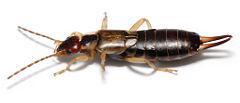 Common earwig, Forficula auricularia
| ||||||||||
| Scientific classification | ||||||||||
| ||||||||||
|
Suborder Archidermaptera †
Suborder Hemimerina
Suborder Arixenina
|
Earwigs is the common name given to the insect order Dermaptera characterized by membranous wings folded underneath short leathery forewings (hence the literal name of the order—"skin wings"). The abdomen extends well beyond the wings, and frequently, though not always, ends in a pair of forceps-like structures termed cerci. The order is relatively small among Insecta, with about 1,800 recorded species in 10 families. Earwigs are, however, quite common globally. There is no evidence that they transmit disease or otherwise harm humans or other animals, despite their nickname pincher bug.
Etymology
Earwig is derived from Old English ēare "ear" and wicga, "insect". (Wicga is in turn related to wiggle, and ultimately to other words implying movement, including way and vehicle, all from PIE *wegh-.) The name comes from the old wives' tale that earwigs burrow into the brains of humans through the ear and therein lay their eggs.[1] Earwigs are omnivores that are predisposed to hiding in warm humid crevices and as such one may crawl into a human ear canal. This is not, however, a location where they are frequently found.[2]
Other languages have words based on the same premise: German Ohrwurm (also: Ohrkneifer, "ear pincher"), French perce-oreille, Danish ørentviste, Slovak ucholak (ucho = ear, lak = scare), and Hungarian fülbemászó ("crawler-into-the-ear"). English has derived a verb from this, to earwig, meaning "to fill someone's mind with prejudice by insinuations" or "to attempt to influence by persistent confidential argument or talk".[3] The German word Ohrwurm has the derived meaning "an annoying tune which I can't get out of my head" (see earworm). Hungarian also uses the phrase fülbemászó dallam with similar meaning as the German above, although without the negative overtones.
Classification
Four suborders within the Dermaptera have been established: [4]
- Archidermaptera: Has a fossil record extending into the Jurassic, with fossils from that period. These have unsegmented cerci and tarsi with 4-5 segments.
- Forficulina: The largest and most familiar group. The cerci are unsegmented, and modified into large, forcep-like structures.
- Hemimerina: Represented by one genus, Hemimerus, with filiform segmented cerci and are wingless, blind and viviparous ectoparasites of African rodents
- Arixenina: Represented by two genera, Arixenia and Xeniaria. As with Hemimerina, they are blind, wingless ectoparasites with filiform segmented cerci. They are ectoparasites of various Southeast Asian bats, particularly of the genus Cheiromeles (i.e., "naked bulldog bats").
Appearance and behaviour
Most earwigs are elongated, flattened, and are dark brown. Lengths are mostly in the quarter- to half-inch range (10–14 mm), with the Saint Helena Giant Earwig reaching three inches (80 mm). Cerci range from nonexistent to long arcs up to one-third as long as the rest of the body. Mouthparts are designed for chewing, as in other orthopteroid insects. Flight capability in Dermaptera is varied, as there are species with and without wings. In those earwigs that have wings (are not apterous), the hindwings are folded in a complex fashion, so that they fit under the forewings. Most species of winged earwigs are capable of flight, yet earwigs rarely fly around.
The abdomen of the earwig is flexible and muscular. It is capable of maneuvering as well as opening and closing the forceps. The forceps are used for a variety of purposes. In some species, the forceps have also been observed in use for holding prey, and in copulation. The forceps tend to be more curved in males than in females.
Most earwigs found in Europe and North America are of the species Forficula auricularia, the European or common earwig, which is distributed throughout the cooler parts of the northern hemisphere. This species feeds on other insects, plants, ripe fruit, and garbage. Plants that they feed on typically include clover, dahlias, zinnias, butterfly bush, hollyhock, lettuce, cauliflower, strawberry, sunflowers, celery, peaches, plums, grapes, potatoes, roses, seedling beans and beets, and tender grass shoots and roots; they have also been known to eat corn silk, damaging the corn. Typically they are a nuisance because of their diet, but normally do not present serious hazards to crops. Some tropical species are brightly colored. Occasionally earwigs are confused with cockroaches because of their cerci and their long antennae.
Earwigs are generally nocturnal and can be seen patrolling household walls and ceilings. Interaction with earwigs at this time results in a defensive free fall to the ground below, and the subsequent scramble to a nearby cleft or crevice.
Earwigs are also drawn to damp conditions. During the summer, they can be found around sinks and in bathrooms. Earwigs tend to gather in shady cracks or openings or anywhere that they can remain concealed in daylight hours. Picnic tables, compost and waste bins, patios, lawn furniture, window frames, or anything with minute spaces (even artichoke blossoms) can potentially harbor these unwanted residents. Upon gaining entry to the basement and living areas of the home, earwigs can easily find cover in undisturbed magazine and newspaper piles, furniture/wickerwork, base boards, carpeted stairways, pet food dishes, and even inside DVD cases and keyboards. Earwigs are exploratory creatures and are often found trapped in poison baited cups or buckets of soapy water.
Pest control
Earwigs can be considered in some ways a beneficial part of the garden, especially when they prey on other insects, but they can become a nuisance because of their habit of positioning themselves within leaves and feeding on soft plant tissues. They prefer cool, moist places, and a rolled up damp newspaper placed where earwig activity is suspected can be effective in collecting them. The newspaper can then either be discarded or shaken out. Placing diatomaceous earth in key spots around the home (bathroom, baseboards, window frames) can be a long-term repellent.
Notes
- ↑ Oxford English Dictionary on "Earwig".
- ↑ Fabian Haas, Dermaptera — Earwigs, Tree of Life web project
- ↑ dictionary.com: earwig
- ↑ Susan M. Rankin and James O. Palmer (pp. 297-299) in Resh, V. H. & R. T. Cardé (Editors) 2003. Encyclopedia of Insects. Academic Press.
ReferencesISBN links support NWE through referral fees
- Grimaldi, D. and Engel, M.S. (2005). Evolution of the Insects. Cambridge University Press. ISBN 0-521-82149-5.
- Engel, M.S. and F. Haas (2007). Family-group names for earwigs (Dermaptera). American Museum Novitates 3567: 1–20.
- J. D. Taylor (1978). The earwig: the truth about the myth. Rocky Mountain Medical Journal 75: 37–38.
- Rod Serling's episode of Night Gallery, "The Caterpillar
- Weems Jr HV, Skelley PE. (1998). European earwig, Forficula auricularia Linnaeus. Featured Creatures. EENY-32. http://creatures.ifas.ufl.edu/veg/european_earwig.htm (31 July 2008).
- Pest Organisms of the Puget Sound Region: Earwigs, Cascade Pest Control
- Keep earwigs away, Islington Council
- Natural Insect Pest Control, eartheasy.com
- Earwig Fact Sheet and Gallery, Harvard University
External links
- Tree of Life info for Dermaptera
- CSIRO Dermaptera page
- "Earwigs eat through your brain" urban legend debunked
- What's That Bug's Earwig Page
- Harvard University information on earwigs
- Earwig Research Centre
- BBC Science and Nature Wildfacts
- ringlegged earwig on the UF / IFAS Featured Creatures Web site
Credits
New World Encyclopedia writers and editors rewrote and completed the Wikipedia article in accordance with New World Encyclopedia standards. This article abides by terms of the Creative Commons CC-by-sa 3.0 License (CC-by-sa), which may be used and disseminated with proper attribution. Credit is due under the terms of this license that can reference both the New World Encyclopedia contributors and the selfless volunteer contributors of the Wikimedia Foundation. To cite this article click here for a list of acceptable citing formats.The history of earlier contributions by wikipedians is accessible to researchers here:
The history of this article since it was imported to New World Encyclopedia:
Note: Some restrictions may apply to use of individual images which are separately licensed.
